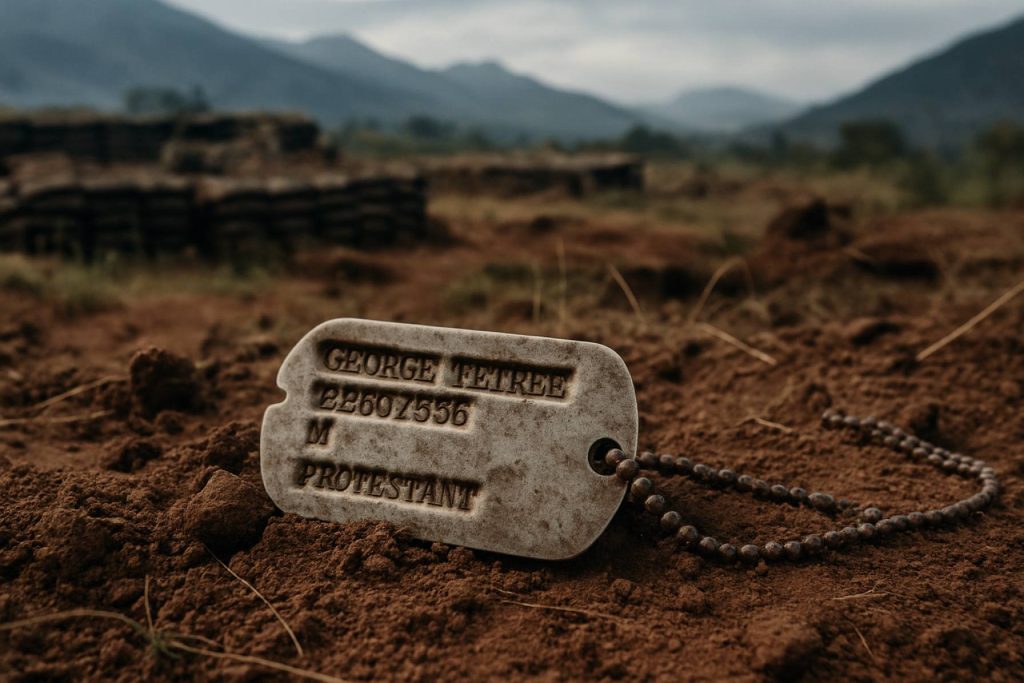
- The Khe Sanh Combat Base remains a powerful symbol of the Vietnam War, marked by relics such as dog tags, unexploded ordnance, and battlefield debris.
- The discovery of Marine E.C. Rayburn’s dog tag, absent from casualty lists, highlights the untold stories and survival of many Vietnam veterans.
- Artifacts left behind—like dog tags—serve as tangible reminders of personal histories, loss, and the complex aftermath of war for those who survived.
- Exploring sites like Khe Sanh reveals not just the physical remnants of conflict, but also prompts reflection on identity, memory, and the ongoing quest for understanding past wars.
- Visitors are reminded that every item from the battlefield can carry unanswered questions and connections to living veterans.
Red earth stains every step at the Khe Sanh Combat Base. Greg Taylor, Army veteran, bent to tie his shoe on the timeworn airstrip when a flash caught his eye — a U.S. Marine’s dog tag half-buried in the Vietnamese soil. It was stamped with “USMC” and the name “E.C. Rayburn,” a lonely artifact among rotting sandbags, twisted barbed wire, and relics of old munitions.
The ground at Khe Sanh, once a cauldron of shrapnel and smoke during the Vietnam War’s most relentless siege, has a way of preserving memories long after soldiers have passed through. The base, held by Marines for 77 blood-soaked days in 1968, remains haunted by the conflict’s ghosts — fragments of Claymore mines jutting from the earth, unexploded shells lying dormant, waiting to be remembered or, worse, stepped on.
Taylor’s pulse quickened. He wiped the soil from the tag. Who was E.C. Rayburn? The tag listed the usual: serial number, blood type, denomination. But when Taylor searched for Rayburn’s name on the Vietnam Veterans Memorial Wall, he found nothing. Rayburn survived. Still, how did this piece of his identity end up abandoned at Khe Sanh?
Just as individual stories often disappear amid the larger machinery of war, found objects like this tag tie together history’s loose threads. They are reminders that the Vietnam War was fought by young men carrying hopes, fears, and tokens from home — only to leave some of them behind. The decades-spanning mystery of Rayburn’s tag illustrates the scattered clues left by those who made it back, and challenges us to ask: What happened after the fighting ended?
Khe Sanh’s airstrip is now a solemn attraction, visited by Vietnamese families, curious travelers, and veterans on pilgrimages. The dog tag served as an unexpected invitation. Who was the Marine in the battle? What did he endure? And why did he leave a piece of himself behind?
Most Americans recall the Vietnam War as a time of division and turmoil, but the individual sagas on the battlefield remain less explored. While Rayburn’s fate did not end in tragedy — his name missing from the list of the fallen — the story of his lost tag is a testament to survival, chance, and the enduring search for meaning after war.
Takeaway: War scatters more than debris — it leaves questions behind. The discovery of a single dog tag at Khe Sanh stirs not just memories, but a call to reconnect with the stories of those who walked away from battle. Every artifact has a tale, urging us to remember, to seek out lost names, and to understand the full arc of those who served.
For more on history, identity, and the enduring impact of conflict, explore resources at Smithsonian Magazine or the American historical record at National Archives.
Khe Sanh’s Silent Witness: What a Lost Dog Tag Reveals About the Hidden Stories of Vietnam Veterans
The Khe Sanh Combat Base, one of the Vietnam War’s most infamous battlegrounds, continues to yield artifacts and raise unanswered questions even decades after the final guns fell silent. The recent discovery of a U.S. Marine’s dog tag belonging to “E.C. Rayburn” spotlights not only the preservation of memory in Vietnam’s red earth, but also the ongoing quest to piece together the fates and stories of those who fought and survived.
Extra Facts & Deeper Insights
1. The Significance of Dog Tags in Military History
Dog tags are more than simple identification tools—they are lifelines in chaos. Each tag lists vital information: name, service number, blood type, and religious preference, allowing for proper care or identification following casualties. Their loss or abandonment can signify wounding, evacuation, or simply the confusion of battle.
– Real-World Use: Families and organizations today use recovered tags to trace missing service members.
– Museum-grade Handling: Artifacts like these, when found, require careful documentation. Report discoveries to the Defense POW/MIA Accounting Agency (DPAA) for possible reunification with families ([DPAA](https://www.dpaa.mil)).
2. Unexploded Ordnance: Ongoing Danger
Khe Sanh is still littered with unexploded shells and war material. The United Nations and local Vietnamese authorities continually warn visitors about potential risks. In fact, over 100,000 people in Vietnam have been killed or injured by unexploded ordnance since 1975 (source: [MAG International](https://www.maginternational.org)).
Safety How-To:
– Stick to marked paths.
– Avoid digging or picking up suspicious items.
– Read up on UXO safety before visiting former war zones.
3. The Siege of Khe Sanh—Context and Legacy
The 77-day siege in 1968 saw some of the most intense fighting of the war, with Marines under near-constant artillery and ground assault. The U.S. dropped over 100,000 tons of bombs around the base—more than in some entire WWII campaigns ([Smithsonian Magazine](https://www.smithsonianmag.com)).
Industry Trends:
War tourism is on the rise in Vietnam. Khe Sanh is part of the “DMZ tour,” appealing to veterans, historians, and younger Vietnamese. Ethical tourism calls for respect and awareness of the trauma sites represent.
4. E.C. Rayburn—The Survivor’s Story
While Rayburn’s name is not on the Vietnam Veterans Memorial Wall, his lost tag underscores a larger truth: many veterans returned with invisible wounds, often overlooked by the official record. Over 2.7 million Americans served in Vietnam; the majority returned to lives forever altered by their experiences.
Controversies & Limitations:
– Many survivors did not receive adequate support for PTSD and health complications.
– Some artifacts, like dog tags, are sold or collected illegally, raising ethical concerns.
5. Preservation and Memory
Sites like Khe Sanh remain part-memorial, part-archeological puzzle. Preservation efforts are often hampered by funding limitations, the tropical climate, and inadvertent souvenir collecting by tourists.
Life Hack:
– When visiting battle sites, respect signage and consider leaving found relics where they lay, or report them to local authorities.
Pressing Reader Questions Answered
Q: Can I search for information about Vietnam veterans or lost artifacts?
A: Yes. Utilize the [National Archives](https://www.archives.gov) for U.S. military records. Many non-profits help reunite lost artifacts with families.
Q: Are visits to Khe Sanh safe?
A: The main memorial and airstrip are generally safe; however, stay vigilant for UXO warnings.
Q: What should I do if I find a dog tag?
A: Do not remove government property from historic sites. Instead, photograph it, note GPS coordinates, and contact the DPAA or local authorities.
Reviews & Comparisons
– Khe Sanh vs. Other War Memorials: Khe Sanh is relatively untouched, offering a raw, evocative experience compared to curated sites like the Vietnam Veterans Memorial in Washington D.C.
– Pros: Authenticity, educational value.
– Cons: Remote location, safety risks, limited amenities.
Security & Sustainability
Maintaining the site requires international cooperation for unexploded ordnance clearance and funding for museum operations. Sustainable tourism focuses on education rather than exploitation.
Quick Tips & Recommendations
– Visit with a guide familiar with the area’s history and safety protocols.
– Use online resources to research names or service numbers before/after visits.
– Support veteran aid organizations working in Vietnam.
Final Takeaway
Artifacts like Rayburn’s dog tag are tangible connections to the past, revealing as much about survival and loss as about the chaos left behind. They are a stark reminder to honor every individual story, and to treat both battlefields and their memories with respect and care.
For deeper context on American military history and remembered stories, visit Smithsonian Magazine or consult the military archives at National Archives.
Remember: History speaks not only through monuments, but also through the ordinary objects soldiers once carried—and left behind.



